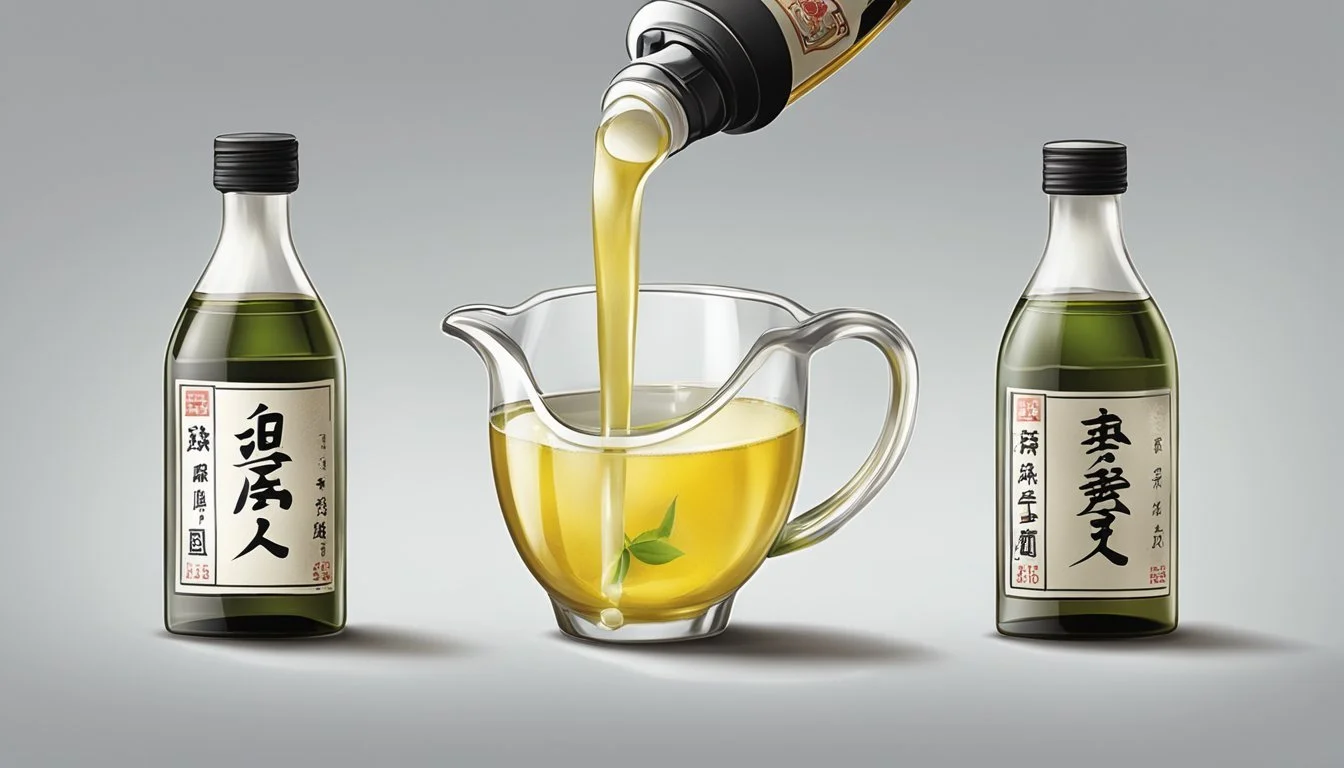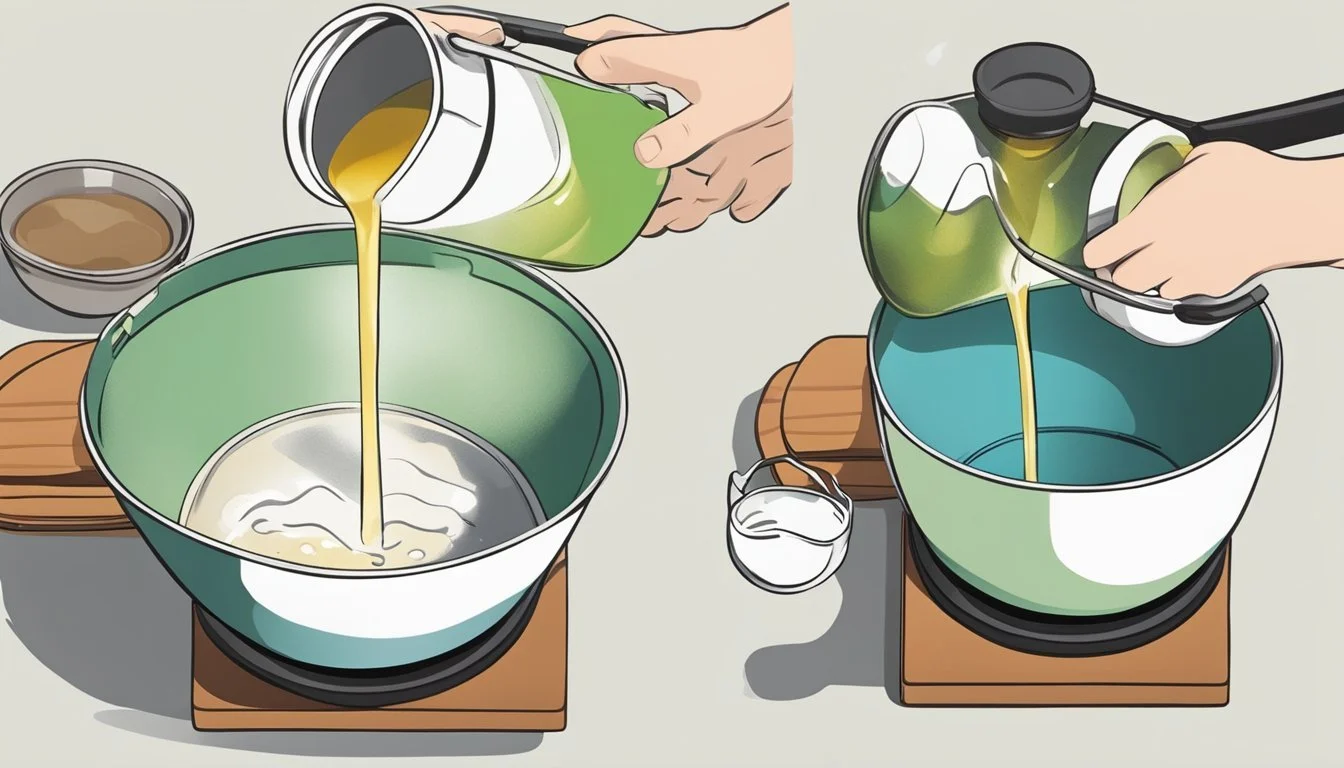How to Substitute Sake for Mirin
A Simple Guide for Cooking Alternatives
Mirin is a staple in Japanese cuisine, known for its unique sweet flavor that enhances dishes with a depth of umami. However, when mirin is unavailable, a common kitchen dilemma arises on how to replicate its complex notes. Sake, another Japanese rice wine, presents itself as a favorable substitute for mirin due to its relatively similar flavor profile, even though it leans more towards the acidic side and has a higher alcohol content.
To effectively use sake as a substitute for mirin, one has to address the variance in sweetness between the two. While mirin is inherently sweet with a lower alcohol percentage, sake is dryer and demands an addition of a sweetening agent to approximate mirin's sweetness. By adding sugar to sake, chefs can achieve a balanced sweetness that closely mimics that of mirin, making it an excellent alternative in recipes.
This method of combining sake and sugar also allows for adjustments, making it possible to cater to different taste preferences and specific requirements of a recipe. A ratio of 3 parts sake to 1 part sugar typically serves to bridge the gap between the two ingredients, creating a fusion that brings sake's flavor remarkably close to that of mirin. This substitution ensures that the integrity of the dishes is maintained even in the absence of authentic mirin.
Understanding Mirin and Sake
When exploring the substitution of sake for mirin, it is crucial to grasp each ingredient's distinct characteristics and culinary roles. This section delineates the specific attributes of mirin and sake, comparing their profiles to underline their similarities and differences essential for successful culinary substitutions.
Characteristics of Mirin
Mirin is a type of Japanese rice wine known for its sweetness and syrupy consistency. Typically, mirin contains an alcohol content (ABV) of about 14%. There are two predominant types of mirin: hon mirin, which denotes true mirin, and aji-mirin, a common variant with similar flavor but a lower alcohol content. Due to its sweetness and umami, mirin not only seasons dishes but also adds a lustrous glaze to food.
Profile of Sake
Sake, another form of Japanese rice wine, is made through a fermentation process involving polished fermented rice. It has a more subtle sweetness compared to mirin, with an alcohol content typically ranging from 15% to 20%. Sake is often appreciated for its versatility, serving both as a beverage and as a cooking ingredient. Its umami flavor contributes depth to dishes without being overpowering.
Mirin Versus Sake
Mirin and sake, while both rice wines, exhibit key differences in terms of usage and taste profile:
Alcohol Content: Sake generally has a higher ABV than mirin.
Sugar Content: Mirin is sweeter than sake because of its higher sugar content.
Culinary Use: Mirin is primarily used in cooking to provide sweetness and sheen to dishes. Sake, while also used in cooking, is more common as a drink.
Taste Contribution: Sake infuses dishes with subtle umami flavors, whereas mirin imparts a richer sweetness.
It is these distinguishing factors that inform how one can substitute sake for mirin in Japanese cuisine.
The Role of Mirin in Japanese Cuisine
Mirin is an indispensable component in Japanese cooking, offering a distinctive sweet flavor and a trademark glossy finish to a variety of dishes. It serves not only as a sweetening agent but also plays a pivotal role in enhancing umami flavors and suppressing unwanted odors in seafood and meat dishes.
Traditional Uses of Mirin
Mirin's origins in Japanese cuisine are deeply rooted, primarily used to add depth and sweetness to teriyaki sauces, glazes, and dressings. It works harmoniously with other ingredients like soy sauce to create a balanced and rich flavor profile.
Teriyaki Sauce: Mirin combines with soy sauce, sugar, and other seasonings to create this iconic glaze.
Glazes: Provides a shiny appearance and helps to caramelize when used in broiling or grilling.
Dressings: Adds a subtle sweetness to dressings, complementing the savory notes of Japanese salads.
Mirin in Modern Cooking
In contemporary cuisine, mirin continues to be a versatile player, used to lend a mellow sweetness to various Japanese dishes. It is also utilized in innovative ways to enhance the flavor profiles of modern creations.
Ramen: A dash of mirin can deepen the broth, giving it a complex taste profile.
Soups and Stews: Mirin is used to season and sweeten, adding a layer of flavor beyond mere sugar.
Mirin's role extends beyond traditional applications, inviting chefs to explore its potential in new and inventive culinary contexts.
Culinary Substitutes for Mirin
When looking to replace mirin in a recipe, consider the balance of sweetness and umami flavor that mirin brings to dishes. Below are suitable substitutes categorized to suit different culinary needs and preferences.
Sweet Substitutes
Mirin is known for its sweet taste. If a recipe calls for mirin and you need an alternative, consider using:
Honey or Maple Syrup: They're natural sweeteners that can mimic the sweetness of mirin. Use a small amount and adjust to taste.
Sugar: A pinch of sugar added to other substitutes can help achieve the desired sweetness. This can be granulated sugar or even brown sugar for a deeper flavor.
Substitute Ratio to Mirin Notes Honey 1:1 Start with less; it is sweeter than mirin. Maple Syrup 1:1 Can add a distinct flavor. Granulated Sugar 1 tsp per tbsp Dissolve in a liquid for better integration into the recipe.
Sake-Based Substitutes
Sake can serve as a base substitute for mirin, but requires additional sweetness:
Sake + Sugar: Combine sake with a bit of sugar to approximate mirin's flavor profile.
Sweet Marsala Wine: This option also brings in a certain depth of flavor, especially for marinades and sauces.
Non-Alcoholic Alternatives
For those seeking alcohol-free or halal substitutions for mirin:
Rice Vinegar: Add a pinch of sugar to rice vinegar to sweeten it.
Apple Cider Vinegar: Its fruity notes can complement dishes similarly to mirin when sweetened.
Substitute Ratio to Mirin Notes Rice Vinegar + Sugar 1 tbsp + 1 tsp Mix well to combine. The sugar counters the acidity of the vinegar. Apple Cider Vinegar 1 tbsp + 1 tsp Mix and adjust according to taste. The natural fruitiness can be a bonus in certain recipes.
These alternatives bring their own unique tastes to dishes but can stand in for mirin, especially when the right balance of sweetness and tang is achieved.
Adjusting Taste and Flavor Balance
When substituting sake for mirin, one must carefully tweak the sweetness and manage the acidity and alcohol content to mimic the complex flavor profile of mirin.
Altering Sweetness
Mirin is notably sweet. Sake, while it can have hints of natural sweetness, typically lacks the pronounced sugary taste of mirin. To compensate, sweeteners should be added. For each tablespoon of sake, one can integrate 1/2 to 2 teaspoons of sugar. This helps to mirror mirin's inherent sweetness and contributes to the overall balance of flavor in the dish. Honey is another suitable sweetener that may be used for its smooth texture and rich taste. Below is a table with suggested sweetener proportions:
Sake (1 tbsp) Sugar (tsp) Honey (tsp) 1 0.5 to 2 0.5 to 1
Managing Acidity and Alcohol
Sake possesses a lower acidity level compared to mirin and a higher alcohol content. To achieve a similar acidity to mirin, one can employ rice vinegar or other types of vinegar, which have the sharpness needed for the dish. However, because vinegar is more acidic than mirin, dilution is necessary. A balance can be struck by using a mixture of vinegar and water, or by selecting seasoned rice vinegar which typically has added sugar and salt.
For tenderizing purposes in marinades, the alcohol in sake can be quite effective. However, mirin's lower alcohol content may be preferred in some recipes. If this is the case, sake should be heated gently to cook off some of the alcohol, enhancing the taste while reducing the alcohol by volume. Here's an outline of actions one can take to manage acidity and alcohol levels:
To mimic mirin's acidity:
Add a splash of rice vinegar to sake.
Use seasoned rice vinegar to avoid extra sweetening steps.
To moderate alcohol content:
Heat sake lightly to evaporate some of the alcohol.
Let the sake-cooking mixture cool before use.
This section covers the essential adjustments for replacing mirin with sake, focusing on modifying sweetness and managing acidity and alcohol content for an authentic flavor result.
Application in Cooking Techniques
Substituting sake for mirin requires an understanding of the impact on flavor and consistency in order to maintain the integrity of traditional Japanese dishes. Here, explore how to adapt sake, with the addition of sugar, to serve as an effective mirin substitute across a range of cooking techniques.
Using Substitutes in Marinades
When marinating with sake instead of mirin, add approximately 1/4 teaspoon of sugar to every tablespoon of sake to balance out the sweetness. This combination works well in marinades, infusing proteins like chicken or fish with a subtle, sweet depth.
Teriyaki Marinade Example:
Sake: 1/4 cup
Sugar: 1 Tbsp
Soy Sauce: 1/2 cup
Garlic (minced): 1 clove
Marinate the protein for at least 30 minutes before cooking to allow the flavors to penetrate.
Adapting Substitutes for Glazes
Glazes often rely on mirin's viscous consistency and sweet profile. To replicate this with sake, increase the sugar slightly and reduce the mixture over low heat to achieve a comparable glaze consistency. This is particularly effective for giving dishes like grilled meats a lustrous finish.
Glaze Proportion Example:
Sake: 1/2 cup
Sugar: 3 Tbsp
Simmer the mixture until thickened to a glaze-like texture.
Incorporating Alternatives into Sauces
Sauces, including dipping sauces and those used in simmered dishes, can benefit from the umami and sweetness mirin imparts. When using sake, the addition of sugar must be tailored to the sauce's desired sweetness. A general guideline is to start with a 1:4 sugar to sake ratio, adjusting as needed for different sauce types.
Dipping Sauce Example:
Sake: 1/4 cup
Sugar: 1 Tbsp
Soy Sauce: 1/2 cup
Vinegar: 2 Tbsp
Whisk ingredients together until sugar is dissolved. Taste and adjust the levels of sugar and sake according to the dish served.
Remember, the key to successful substitution lies in striking the right balance between the alcohol content of sake and the sweetness that mirin provides. Through careful measurement and taste testing, sake can confidently replace mirin in various Japanese cooking methods.
Shopping and Pantry Management
When seeking to replace sake with mirin in recipes, it's important to choose the right substitutes and understand proper storage methods to maintain a well-stocked, adaptable pantry.
Identifying Quality Substitutes
When shopping for a mirin substitute, one should look for alternatives that can mimic the sweet and tangy profile of this fermented rice condiment. Sake, a common pantry staple, is often available in different varieties. For instance, a sweeter variety of sake can be a direct substitute for mirin without any adjustments. In the event of using a drier sake, adding a sweet component such as sugar or fruit juice can achieve a balance closer to mirin. Homemade mirin can be crafted using a combination of sake and sugar, allowing for control over the sweetness level.
Substitute Characteristics Adjustment Needed Sweeter sake Closely resembles mirin None Drier sake Lacks the sweetness of mirin Add sugar or juice DIY Mirin Sake with added sugar to taste Varies
Storing Substitutes and Mirin
Substitutes for mirin and mirin itself should be stored properly to preserve their quality. They typically last longer when kept in a cool, dark place, away from direct sunlight and heat. Opened bottles of sake and homemade mirin should be refrigerated to slow down the degradation process, ensuring they retain their flavor and aroma for future use.
Creating a Versatile Pantry
A versatile pantry contains a mix of items that can serve multiple purposes, and mirin substitutes are no exception. Ingredients like rice vinegar and a sweetener (sugar or honey) can stand in for mirin when mixed in correct proportions. Keeping these ingredients on hand, along with sake for those who enjoy occasional ferment-based recipes, makes for an adaptable cooking environment.
Rice vinegar: Acidic; sweeten with sugar or honey to mimic mirin.
Sake: Can be sweetened if necessary; a key component in homemade mirin.
Sweeteners: Honey, sugar, or fruit juices to adjust the sweetness of a substitute.
By managing these elements properly, one ensures they have the resources to replicate the distinctive qualities of mirin in any dish.
Crafting Homemade Mirin
Creating homemade mirin involves specific proportions of ingredients and a controlled fermentation process to achieve a sweetness and flavor profile similar to commercial mirin.
DIY Mirin Proportions
To mimic the sweetness of mirin, one can mix distilled rice liquor such as sake with sugar. A common ratio used is:
3/4 cup sake
2 tablespoons of sugar
This mixture should be heated gently to dissolve the sugar completely before allowing it to cool. One can adjust the amount of sugar to match their desired level of sweetness.
Fermentation Process for Homemade Mirin
Traditional mirin is made through a fermentation process that involves steamed glutinous rice, koji (fermented rice), and water. However, creating a quick homemade version does not involve prolonged fermentation. Instead, the combination of sake and sugar creates a fortified wine that mimics mirin's flavor profile for cooking needs. To achieve a more authentic taste, one might allow the mixture to ferment for a short period, but this is not typical for quick homemade mirin substitutes.
Understanding Alcohol Content and Dietary Restrictions
When substituting sake for mirin, the alcohol content and potential dietary restrictions are critical considerations. These factors directly influence the taste and suitability of the dish for various individuals.
Alcohol Content in Cooking
Sake, a Japanese rice wine, typically contains 15-20% alcohol by volume, which is considerably higher than mirin, a sweeter rice wine with about 14% alcohol content. In cooking, alcohol evaporates partially, but a significant amount can remain, impacting both the flavor and dietary acceptability. For those who are sensitive to the taste of alcohol, or prefer a less sweet alternative to mirin, sake can be an appropriate substitute due to its higher alcohol content and more subtle sweetness.
Alcohol retention in cooked foods:
Flamed: 75% retained
Baked, 1 hour: 25% retained
Baked/stewed, 2+ hours: 5-10% retained
Non-Alcoholic and Halal Options
Seekers of non-alcoholic or halal alternatives to mirin might consider options such as grape juice or non-alcoholic wines. Since these substitutes are typically alcohol-free, they cater to dietary constraints while still imparting a fruity sweetness that can mimic mirin's flavor profile. To adjust for taste, a cook may need to blend in a small amount of vinegar or lemon juice to offset the sweetness and achieve a more balanced flavor akin to sake.
Halal substitutions for mirin:
Non-alcoholic wine + a dash of vinegar
Grape juice + a teaspoon of lemon juice
For those requiring a non-alcoholic or halal substitute, the final dish will be similar in taste to one made with sake, but without the presence of alcohol.
Conclusion
In the culinary journey of exploring diverse flavors, one often encounters scenarios where ingredient substitutions are necessary. Sake, a fermented rice wine, serves as an excellent stand-in for mirin, a staple in Japanese cuisine known for its sweet and umami-rich profile. The two share a similar base but present with distinct flavor nuances due to differences in sugar and alcohol content.
To successfully substitute sake for mirin, adding a sweet component is crucial. For every tablespoon of sake, incorporating about half a teaspoon of sugar replicates mirin's sweetness. This blend achieves a comparable flavor balance, allowing dishes to maintain their intended taste profile.
Furthermore, when incorporating sake as a substitute, it is advisable to add it earlier in the cooking process. This allows for the evaporation of excess alcohol, leaving behind a mild flavor that closer resembles mirin's mellow character.
Sake to Mirin Substitution Guide:
Sake Volume Added Sweetener Ideal Usage 1 tbsp 1/2 tsp sugar Sauces, marinades 1/4 cup 2 tsp sugar Glazes, dressings 1/2 cup 1 tbsp sugar Braises, stews
By adhering to these simple guidelines, culinary enthusiasts and professionals alike can confidently pivot in their recipes, ensuring continuity in both the cooking process and final presentation.






